| Back Number | No.18 2005/06/22 | |||
| News | Japan Day and Japan Week Held |  |
||
| Pavilions | Pacific Islands Pavilion (Global Common 6) Brunei Darussalam Pavilion(Global Common 6) Philippine Pavilion(Global Common 6) |
|||
| Column | Robot Project | |||
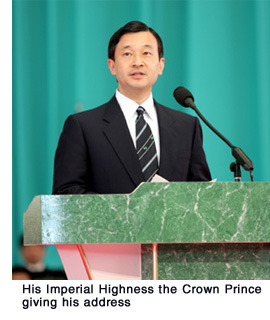 Japan Day, the National Day of EXPO 2005 Aichi, Japan’s host country, was held on June 6 followed by Japan Week which lasted until the 12th.
Japan Day, the National Day of EXPO 2005 Aichi, Japan’s host country, was held on June 6 followed by Japan Week which lasted until the 12th.The Japan Day Ceremony opened with a Gagaku (ancient court music) performance by the Music Department of the Imperial Household Agency’s Board of the Ceremonies. This was followed by speeches by Shoichiro Toyoda, Chairman of the Japan Association for the 2005 World Exposition and Prime Minister Junichiro Koizumi, Honorary Chairman of EXPO 2005. His Imperial Highness the Crown Prince, Honorary President of EXPO 2005, then gave an address. In it, the Crown Prince said, “Japan Day is a unique opportunity for people around world to get to know about our efforts as host of EXPO 2005 Aichi, Japan towards leaving an even better Earth behind for future generations. I speak these words in hope that with this Japan Day as a trigger, people the world over will deepen their understanding of such efforts by Japan and that opportunities for us to work together in tackling the Earth’s environmental issues will gather further momentum.” |
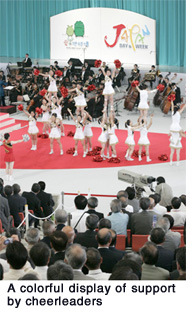 Then youths, who are performing the Gundoku group recitation of an epic poetic drama, entitled “One Seed,” at Japan Pavilion Seto, energetically declared Japan Day and Japan Week open. Later, 175 cheerleaders from universities in Aichi filled the venue to give a colorful performance to the tune of Yagibushi, a gay traditional Japanese folk song, cheering on the holding of Japan Day and Japan Week.
Then youths, who are performing the Gundoku group recitation of an epic poetic drama, entitled “One Seed,” at Japan Pavilion Seto, energetically declared Japan Day and Japan Week open. Later, 175 cheerleaders from universities in Aichi filled the venue to give a colorful performance to the tune of Yagibushi, a gay traditional Japanese folk song, cheering on the holding of Japan Day and Japan Week.Next, the Japan Pavilions, corporate pavilions and other Japanese pavilions were introduced as attendants from each Japanese pavilion came on stage. Actress Keiko Takeshita, Chief Pavilion Director of Japan Pavilions, called upon people to come visit the Japan Pavilions. At the end of the ceremony, Sadao Watanabe, world-renowned musician and General Superintendent Japan Pavilion Projects, appeared on stage with 200 children. Children singing and using body-language to express the EXPO 2005’s message song “Share the World" - which Watanabe composed - to the accompaniment of an orchestra and his saxophone closed the Japan Ceremony. |
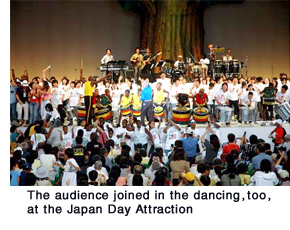 In the Japan Day Attraction, Sadao Watanabe again appeared, this time with children from Japan and Brazil who brought much excitement to the stage.
In the Japan Day Attraction, Sadao Watanabe again appeared, this time with children from Japan and Brazil who brought much excitement to the stage.From June 7 to 12, Japan Week Selection - Traditional and Contemporary, Sadao Watanabe’s Rhythm World - Meet the EXPO, and Sadao Watanabe’s Rhythm World (Finale) were held as part of Japan Week events, at EXPO Dome. In “Traditional and Contemporary” held on the 7th, melodies that represent various periods in Japan, from the court music of the Heian period to the music of the Shamisen (a three-stringed instrument) from the Edo period were performed under the theme of Kanaderu, which means to play a melody on a musical instrument. The 8th and 9th featured children from around Japan who performed the Eisa of Okinawa and other dances of the four seasons under the theme of Odoru (to dance), and powerfully played the Japanese drums under the theme of Tataku (to beat). The theme of the 10th was Tsudou, which means to gather. This stage was a combination of song, dance and performances of musical instruments. Audiences became one with the stage as they joined in the dancing of the Awa Odori of Tokushima Prefecture. Meanwhile, Sadao Watanabe Rhythm World - Meet the EXPO, held between June 7 and 10, expressed Earth rhythms through performances of folk instruments and dances by youths from Brazil, Portugal, Senegal, the United States, and Japan. The Finale held on June 12 was the grand sum of this event in which an audience of more than 3,000 became one with Sadao Watanabe and a total of roughly 370 children as they shook the venue with their dynamic singing and rhythms. |
![]()
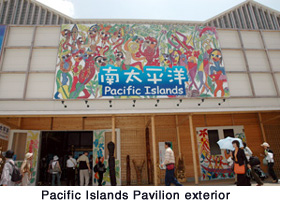 “The Beautiful Pacific;” this is a theme truly befitting the Pacific Islands Pavilion, a joint pavilion of 11 South Pacific island nations that invoke images of a dazzling sun, crystal blue coral reef oceans, the splendor of brightly colored tropical flowers, and smiles on the faces of the down-to-earth islanders you meet in an environment where time seems to move at a leisurely pace.
“The Beautiful Pacific;” this is a theme truly befitting the Pacific Islands Pavilion, a joint pavilion of 11 South Pacific island nations that invoke images of a dazzling sun, crystal blue coral reef oceans, the splendor of brightly colored tropical flowers, and smiles on the faces of the down-to-earth islanders you meet in an environment where time seems to move at a leisurely pace.The region inside the triangle in the South Pacific created by tying New Zealand, Easter Island and Hawaii together is known as Polynesia. Islands to the west of this triangle in the waters to the north of the Equator is in Micronesia, and those in the waters to the south of the Equator is in what is called Melanesia. Polynesian countries participating in EXPO 2005 Aichi, Japan are Samoa, the Kingdom of Tonga, and Tuvalu. From Micronesia are the Republic of Kiribati, Republic of the Marshall Islands, the Federated States of Micronesia and the Republic of Palau. Melanesia is represented by Papua New Guinea, the Solomon Islands, the Republic of Vanuatu and the Republic of the Fiji Islands. Upon entering the pavilion, visitors will enter a corner that introduces the unique history, culture and society of each island through videos, panels and precious items on display. This, in itself, is like island hopping in the South Pacific. Clothing and daily commodities made of palm and pandanus leaves, Tapa cloth, which is cloth made of tree bark that is unique to the South Pacific, and other items show the wisdom of the people in the utilization of limited island resources. Vanuatu introduces the coming-of-age rite of Pentecost Island in which young men tie their ankles with vines and jump head down from a tall tower. This is said to be the origin of bungee jumping. In addition to video footage, each country introduces its unique traditional ceremonies and festivals through various exhibits, such as giant masks used in ceremonies and wooden wares for holding kava (a beverage made from the pounded roots of kava, a member of the black pepper family). Stick charts of the Marshall Islands, which are nautical charts made of sticks and seashells, surprise visitors for the advanced navigational skills that they represent from an age before writing existed on the islands. A Venus shell with a diameter of about 1 meter is scheduled to be soon brought to an aquarium set up in the next corner that is filled with rare tropical fish. The South Pacific is a natural treasury of a wide variety of marine life, including such rare life forms as dugongs (also known as sea cows or sea pigs) and sea turtles. |
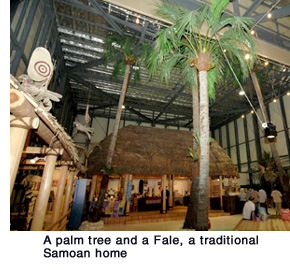 After passing through this area, visitors will suddenly find themselves in a wide, open space. This is as close to being in the South Pacific as one could get in Japan. A palm tree brought directly from Tonga and a Fale, which is a traditional Samoan house consisting primarily of roof and posts, can be found here.
After passing through this area, visitors will suddenly find themselves in a wide, open space. This is as close to being in the South Pacific as one could get in Japan. A palm tree brought directly from Tonga and a Fale, which is a traditional Samoan house consisting primarily of roof and posts, can be found here.In the center is a Kalia, a large voyaging canoe. This is a reproduction of the canoes of several thousands of years ago that was made in and transported from Tonga. It can be said that the people of the South Pacific repeatedly relocated from Southeast Asia to the South Pacific over centuries. You can picture the bold hearted people of the past who paddled out into the rough seas in a canoe carved out of a large log and a sail made of pandanus leaves. |
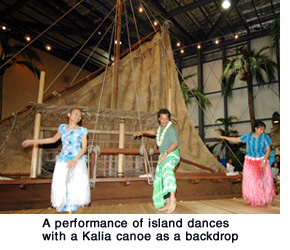 In front of the Kalia is a stage where visitors can watch performances of various island dances while drinking juice directly from a straw stuck into a coconut. The beverage is sold within the pavilion. This is something you can experience only here at this joint pavilion.
In front of the Kalia is a stage where visitors can watch performances of various island dances while drinking juice directly from a straw stuck into a coconut. The beverage is sold within the pavilion. This is something you can experience only here at this joint pavilion.While the Pacific Islands Pavilion enables visitors to fully enjoy “The Beautiful Pacific,” it also appeals the importance of the people of the world joining hands in order to protect the beautiful nature, unique culture and history of the South Pacific. The rising of the sea caused by global warming is a serious issue for the Marshall Islands, Kiribati, Tuvalu and other islands which are of the coral reef type and rise only several meters above sea level. The treatment of garbage left by overseas tourists is another important environmental issue faced by the islands of the South Pacific. Let us all work together with the people of the world to protect “The Beautiful Pacific.” |
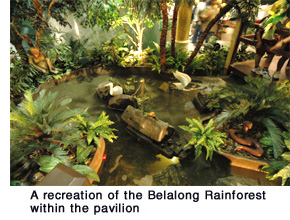 Brunei Darussalam (Jewel of the East) is a small kingdom of some 350,000 people located in the northwest of Borneo Island facing the opening sea of the South China Sea. Brunei Darussalam is well-known as an affluent country blessed with natural resources such as oil and liquefied natural gas. Thanks to its revenues from natural resources, the country’s precious forest resources - in the form of the tropical rainforests that cover nearly 80% of Brunei Darussalam - has remained virtually untouched to this day without any large scale development or exploitation.
Brunei Darussalam (Jewel of the East) is a small kingdom of some 350,000 people located in the northwest of Borneo Island facing the opening sea of the South China Sea. Brunei Darussalam is well-known as an affluent country blessed with natural resources such as oil and liquefied natural gas. Thanks to its revenues from natural resources, the country’s precious forest resources - in the form of the tropical rainforests that cover nearly 80% of Brunei Darussalam - has remained virtually untouched to this day without any large scale development or exploitation.The theme of the Brunei Darussalam Pavilion is “The Green Heart of Borneo: BRUNEI, A Kingdom of Unexpected Treasures.” Nearly half of the exhibition space recreates the atmosphere of the Belalong Rainforest, world-famous for the tropical rainforest field studies conducted here and Research Center also located here. So, when you visit Brunei Darussalam Pavilion, you will experience a replica of the real Belalong pathways which have been constructed in the pavilion itself for you to stroll along, and hear the sounds of animals, birds, insects and water flowing from the artificial fountain. If you shift your gaze towards the riverbank, you will find realistic crocodiles, snakes, scorpions and other objects of art that look as if they are about to spring to life. Apart from that, you can also see the flowers, plants and trees found in the rainforest jungles. In the real Belalong Rainforest, the Research Center is where researchers from around the world gather and do research on new species which are continually being discovered there. You can also see the replica of the main Mosque located in the capital city Bandar Seri Begawan, which is one of the most magnificent mosques in Southeast Asia. |
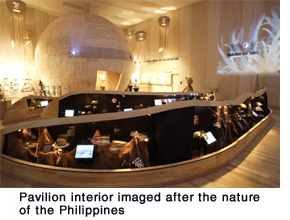 The theme of the Philippine Pavilion, which won the “Category C” Gold Prize in the Nature’s Wisdom Award announced on May 26, is “USBONG: Seeds of Life.” “Usbong” is a Filipino term that means “the growth of a seed.”
The theme of the Philippine Pavilion, which won the “Category C” Gold Prize in the Nature’s Wisdom Award announced on May 26, is “USBONG: Seeds of Life.” “Usbong” is a Filipino term that means “the growth of a seed.”The façade or the exterior of the Philippine Pavilion is designed around two keywords: weaving and poetry. The aluminum strips are literally woven, evoking the weaving of fibers and coconut fronds in myriad traditions; the poetry of the elegant Hanunoo Mangyan tribe of Mindoro Island in the Philippines is executed as laser-cut ancient script perforated elements on the aluminum interwoven with its Japanese translation. The interior is a continuous weaving of fabrics on the walls and ceiling with panels of beautiful fabrics and textiles woven to architectural specifications. They double as a multiple surface for a film and sound installation depicting Philippine destinations, lifestyle and culture, eco-tourism communities and indigenous flora/fauna. Engineered coconut is used as flooring and consoles for exhibitries. The “Essences” section stands out within the pavilion. It is a sphere made of 76,000 coconut shells - a space for Philippine indigenous scents and oils. The upper lounge of the sphere is a private place to experience therapeutic and healing massage that completes the concept of health and wellness, Philippines-style. The inspiration for all the design, creative elements and curation is the coconut. Its wealth of usage from the seed to its trunk, leaves, bark, fruit and by-products earned the title: “Tree of Life.” It expresses the Filipino sense of wholeness, interconnectedness and interactivity. |
![]()
|
The sound of trumpets played by robots reverberated loudly through the venue at the EXPO 2005 Aichi, Japan opening ceremony held on March 24, and a performance by robots left a strong impression on people around the world. With the opening of EXPO 2005, 9 robot types representing 5 fields - child-care, visitor guidance, sanitation, security and next-generation wheelchairs - began working at various locations around the EXPO venue. These are robots being developed with the target of achieving commercial application by around 2010. Maintenance of these robots is conducted at Robot Station located in the Interactive Fun Zone where visitors can interact with them at any time. PaPeRo, a child-care robot, is always surrounded by children who enjoy having conversations with it. Seeing the maintenance work on the other robots as well as watching demonstrations are also quite enjoyable. Meanwhile, the Prototype Robot Exhibition was held at Morizo & Kiccoro Exhibition Center for 11 days between June 9 and 19 as part of this Robot Project being held at EXPO 2005. The theme was “A 2020 City: Living with Robots.” The exhibition was organized by the New Energy and Industrial Technology Development Organization (NEDO) and the Japan Association for the 2005 World Exposition. Prototype robots (65 robot types representing 8 fields) - including robots that work at shops, factories or hospitals, at disaster areas and dangerous sites, and in households - which were gathered through an open call to universities, corporations and others for participation, were exhibited. The target for the commercial application of these robots is around 2020. The robots instilled awe and excitement in the many visitors who saw them working in various aspects of people’s lives at an exhibition space designed to depict a cityscape 15 years into the future. Japan, which is a world leader in robot technology in the manufacturing field, utilized accumulated technology and know-how into the field of services to suggest, here, a future in which robots and humans coexist. One of the important development concepts for working robots is to have a single robot operate various household electrical appliances, computers and other items upon the command of humans. For example, there was ApriAlpha™, Apli the sharp ear. No matter where in the room the command is being given from, this robot looks toward the direction that the voice is coming from, and responds verbally. It does what it is told, including turning on lights or a TV in a room, or adjusting the controls on an air conditioner. |
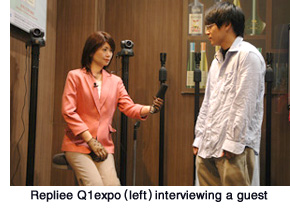 Repliee Q1expo, an android that looks just like a human being and is capable human-like movement, played the role of a reporter and interviewed visitors, exhibiting its capacity for holding smooth conversations with humans. Meanwhile, there are robots like Robovie & Wakamaru, which performed a comedy routine on stage. In robots such as these, “cuteness” as a robot was pursued. Another important research theme for the future is the pursuit of a design that makes it easy for people to comfortably accept working robots.
Repliee Q1expo, an android that looks just like a human being and is capable human-like movement, played the role of a reporter and interviewed visitors, exhibiting its capacity for holding smooth conversations with humans. Meanwhile, there are robots like Robovie & Wakamaru, which performed a comedy routine on stage. In robots such as these, “cuteness” as a robot was pursued. Another important research theme for the future is the pursuit of a design that makes it easy for people to comfortably accept working robots. |
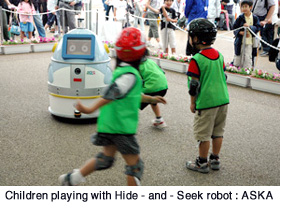 There are many occasions for working robots, such as Hide - and - Seek robot : ASKA and Partner Ballroom Dance Robot PBDR - which danced with a human on stage - to come into direct contact with people. Therefore, adequate safety measures must be implemented. Careful checks are said to have been made in preparation for the exhibition.
There are many occasions for working robots, such as Hide - and - Seek robot : ASKA and Partner Ballroom Dance Robot PBDR - which danced with a human on stage - to come into direct contact with people. Therefore, adequate safety measures must be implemented. Careful checks are said to have been made in preparation for the exhibition. |
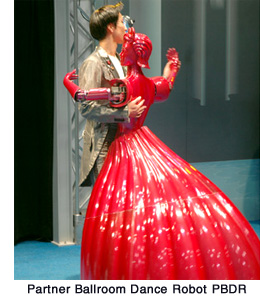 While various demonstrations were held at the exhibit, not all of them went smoothly. However an EXPO is a valuable chance for researchers to conduct demonstration experiments, and we are sure that robotics will progress even further through this opportunity that enabled the robots to go outside the laboratory and give demonstrations amidst the hustle and bustle of the EXPO. Even failures are sure to become a stepping stone towards the advancement of robot technology.
While various demonstrations were held at the exhibit, not all of them went smoothly. However an EXPO is a valuable chance for researchers to conduct demonstration experiments, and we are sure that robotics will progress even further through this opportunity that enabled the robots to go outside the laboratory and give demonstrations amidst the hustle and bustle of the EXPO. Even failures are sure to become a stepping stone towards the advancement of robot technology.We are told that some of the developers who participated in the exhibition became a robotics researcher after they were moved as a child when they visited a robot exhibition produced by Osamu Tezuka (creator of the Astro Boy animation series) 35 years ago at Osaka Expo ’70. New robot scientists may perhaps be born from among the children who were excited at seeing a glimpse into a future in which we will coexist with robots. |
| EXPO 2005 AICHI, JAPAN Newsletter | |
| To read past issues:Back Number | |
| Editor/Publisher: Japan Association for
the 2005 World Exposition Head Office: 1533-1 Ibaragabasama, Nagakute-cho Aichi 480-1101 Japan Nagoya Office: Nagoya Daiya II Bldg 4F, 3-15-1 Meieki Nakamura-ku, Nagoya, Aichi 450-0002 Japan Tokyo Office: Iino Bldg 8F, 2-1-1 Uchisaiwai-cho Chiyoda-ku, Tokyo 100-0011 Japan |
 |
© Japan Association for the 2005 World Exposition
